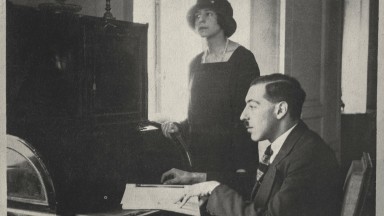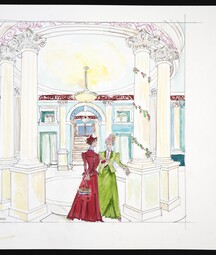Nineteen envelopes sealed containing private and business correspondence between James Joyce and Paul Léon in the years 1930-1940 and the latter’s correspondence business and otherwise, relating to Mr Joyce, his family and work. This is the property of Paul Leon, 27 rue Casimir, Paris. To be returned to him at his request. In case of his death to be handed to Mr James Joyce. In case of both being dead to be deposited with the Public Library of Ireland or the British Museum to be made accessible for literary use fifty years after Mr Joyce’s death...
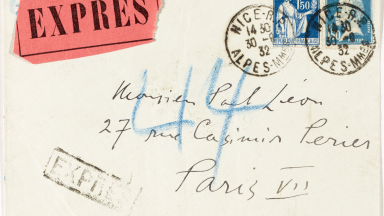
Envelope from James Joyce to Paul Léon, 27 rue Casimir Périer, Paris VII (JJPL 01/05/223 (3))
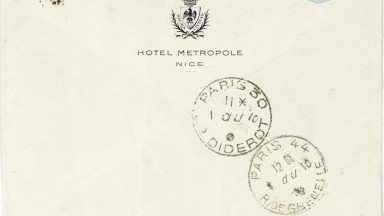
Envelope from James Joyce to Paul Léon, 27 rue Casimir Périer, Paris VII (JJPL 01/05/223 (3))
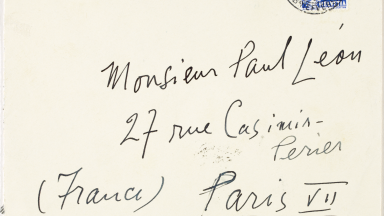
Envelope from James Joyce to Paul Léon, 27 rue Casimir Périer, Paris VII (JJPL 01/05/223 (4))
In September 1940, a slender man, moustached with aquiline features, handed over nineteen envelopes to the Irish Legate in Paris, Count O’Kelly, Ireland’s diplomatic representative to Nazi‑occupied France. The man was Paul Léon. Inside the envelopes was a precious legacy for modern literature and for Ireland, a collection of correspondence which today forms the nucleus of the National Library’s Joyce collections. The letters offer a window into the final decade of Joyce’s life—his money problems, his declining health, his efforts to have Ulysses and Finnegan’s Wake published, and his concern for his daughter, Lucia.
Léon and Joyce become friends in Paris in 1928. From then until 1940, they met regularly at Léon’s apartment on rue Casimir. Léon became an indispensable confidant and friend, as well as an occasional legal and financial advisor. As Joyce’s sight faded, he and Léon would sit at a cramped table to correct the galley proofs of Finnegan’s Wake: a painstaking task, given the idiosyncrasies of that book’s text.
Léon’s son, Alexis, would say in later years that each saw in the other a reflection of his own exile: Joyce had fled an Ireland which he found oppressive, Léon the Russian Revolution Léon was Jewish and came from a wealthy family, one that had, until the First World War, held a monopoly on the export of grain to the Baltics. The world‑shaking drama of 1917 quickly made it apparent that Russia was no longer a safe place for the Léon family. And so, to Paris, where Léon would become an expert on two of the great French philosophers: the radical Rousseau and the liberal Constant. His love of letters would lead him to meet Joyce, and from there, circuitously, to the Irish Legation in 1940.
The Joyces and the Léons fled Paris when it fell into the hands of the Nazis, regrouping in the village of Saint‑Gérand‑le‑Puy. This would be Joyce’s last home in France. Paul’s wife, Lucie, remembered the two friends strolling together arm in arm on the road to Lyon, or sitting against a felled tree, sometimes speaking, sometimes in silence. ‘The calamity of France seemed complete,’ Lucie would go on to write. ‘We were marking time.’ Joyce would soon leave for Zurich, where he would die in 1941. The Léon family left Saint‑Gérand‑le‑Puy shortly after, taking the fateful decision to return to Paris.
It seems inconceivable today that a Jewish family would choose to return to Nazi‑occupied territory. Alexis wrote that his father took the decision partly because he did not consider himself ‘political’, and partly for more prosaic reasons: he wanted to finish his book on Rousseau and he wanted his son to take his baccalaureate. We know now that it did not matter to the Nazis whether a Jewish person was ‘political’ or not, but in 1940, the Léons were far from alone in failing to grasp the unimaginable horror of the Holocaust, and the danger of returning to Paris.
Paul Léon was arrested by the Gestapo on 21 August 1941. He was part of the first group of arrestees to be transferred to what would become France’s most infamous detention camp at Drancy: a modernist urban community of high‑rise apartment blocks, transformed into the nerve centre of the Nazis’ detention and deportation operation in France. The next day, he began to write letters to Lucie, recording his time in the camp. Lucie, for her part, volunteered for the Red Cross to gain access to Drancy, and while the two were never able to speak, they were able to smuggle correspondence in and out of the camp, and even to see each other from a distance.
Paul’s letters chronicle the physical and spiritual ordeal of Drancy. They begin hopeful, but grow progressively more desperate as the conditions at the camp – overcrowding, starvation rations and disease – take their toll. Food becomes a central, at times obsessive, preoccupation. He recounts the aches and pains throughout his body. As his condition worsens, his language changes, from the French of his adult (intellectual) life, to the Russian of his childhood.
Even when the concerns of the body become the focal point of his existence, however, Léon’s extraordinary character and love of letters shines through. He writes to Lucie that he wants to revise Ulysses (alongside Beckett), to collect his memories of Joyce, and to continue his work on Constant and Rousseau. Even his suffering passes through the lens of literature:
My head drops, not from sleep, but from lethargy. ‘My how his head falls’, that is from Anna Livia [from Finnegan’s Wake], and it resonates like a fall into a great void…
Literature provides one source of consolation in the darkest of times. In one of Léon’s final letters from Drancy, it is, of course, to his loved ones that he returns:
My dear, we have been counted and tomorrow we will leave, where or how I do not know… I want you to remember all of my care for you and Alexis… I pray to God for you and Alexis and [all my true friends]. I hope I will see you again, but my hope is not so strong… But the most important thing for me is to tell you that I love you as I loved you twenty years ago, and if I never see you again – it will be you that I love forever. May God keep you, you and Alexis. I embrace you, as I love you. Always yours, Paul.
From Drancy, Léon was sent first to the transit camp of Compiègne, before eventual deportation to Silesia. He was murdered on the train tracks between Auschwitz and Birkenau.
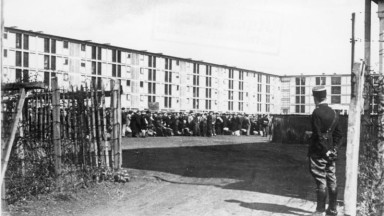
Drancy internment camp, August 1941
The Polish journalist and Auschwitz survivor, Marian Turski, spoke at the 75th anniversary of the liberation of the camp four years ago, close to where Paul Léon was murdered. ‘Auschwitz didn’t suddenly fall from the sky. Auschwitz crept up, tiptoed along with small steps, moved closer and closer, until the things that happened here began.’ Léon’s letters from Drancy constitute an archive as extraordinarily important in their own way as the Joyce archive he had recently retrieved at such risk to himself, documenting that process in painful, moving detail.
Ireland and the National Library owe a great debt to Paul Léon. It is no exaggeration to say that the papers he retrieved and cared for constitute one of the pillars of modern Joyce studies. When Sean Ó Mórdha concluded his documentary on James Joyce in 1983, he recorded Alexis Léon’s memories of his father’s collaboration with Joyce, filmed in Léon’s apartment on rue Casimir. He titled his documentary with a question: ‘Is there one who understands me? If there ever was one, that one was Paul Léon. As we mark Holocaust Memorial Day, one way to repay that debt is to consider the life and death of this extraordinary person—one among six million.
-----------
Paul Léon’s letters are collected in James Joyce and Paul L Léon: The Story of A Friendship Revisited, edited by Alexis Léon, Anna Marie Léon (Paul’s daughter‑in‑law), and Luca Crispi.
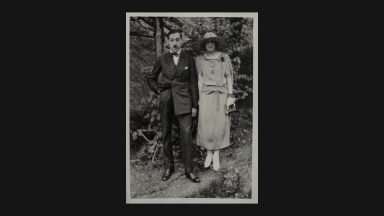
Pictured: Paul and Lucie Léon © The Léon family
